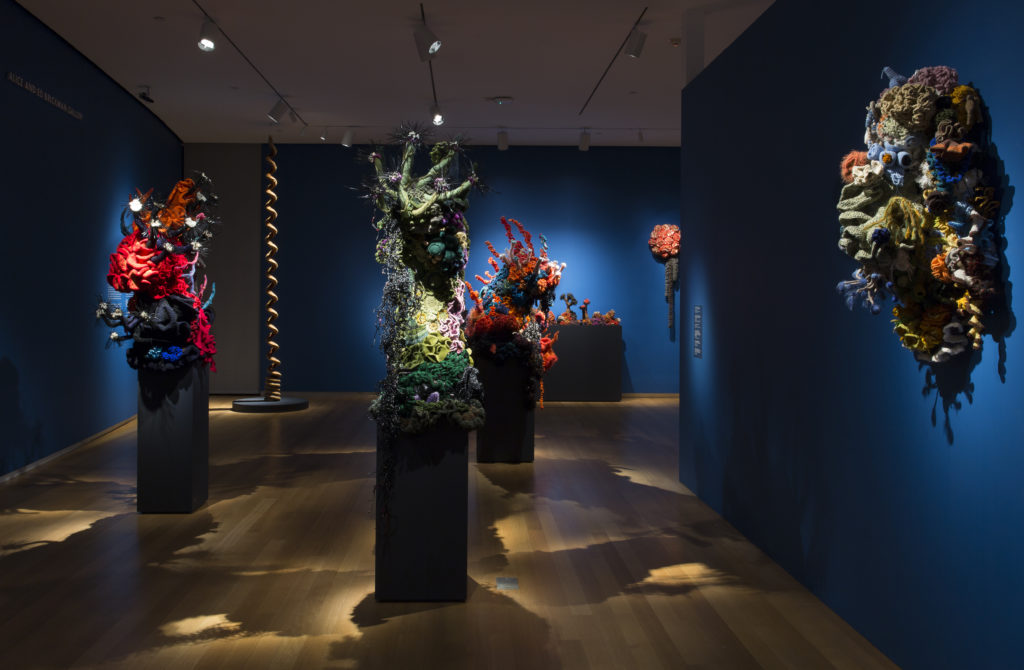On January 22, 2017, the IFF’s exhibition Crochet Coral Reef: TOXIC SEAS ends its season at the Museum of Arts and Design, NY. Here IFF director Margaret Wertheim offers some reflections on the show’s intersection with trends in art and science over the past year.
2016 witnessed a renewed interest in feminist art practice in the USA and Europe. In NY, the Queens Museum hosted the first major retrospective of Miele Laderman Ukele’s “maintenance art,” a term she initially coined to encompass the domestic work women do, and later expanded to include work by janitors, museum care-takers and sanitation workers. Aeon magazine also published an essay on maintenance and its resonances for the sciences, where, the authors note, the bulk of effort also goes into maintaining and stabilizing theories and practices rather than much vaunted “innovation.” Feminists have long championed maintenance, and at the IFF our Crochet Coral Reef project is also about visibilizing unseen care work, since caring for the environment is necessarily an extension of caring for one another, a set of responsibilities that still falls largely to women.
In London at the ICA a series of films was curated by Radclyffe Hall, a collective of writers and artists who explore “culture, aesthetics and learning through the lens of contemporary feminism.” And in Los Angeles an initiative launched by Metabolic Studio aims to “animate the archives” of the Women’s Building, a pioneering site of feminist art started in 1973 by Judy Chicago, Sheila de Bretteville and Arlene Raven. Meanwhile Schimmel Hauser and Wirth in LA opened with fanfare devoting its entire 100,000 square feet of space to the inaugural show Revolution in the Making: Abstract Sculpture by Women 1947 – 2016. This vast diverse conclave featured assemblages by Lee Bonticu and Louise Bourgeois, groves of wire pod-forms by Ruth Asawa, geometric nets by Gego, topologically knotted ropes by Francois Grossen, and much more.
2016 has also been an important year for women in science, beginning on a sober note with much needed commentary about the ongoing issue of sexual harassment by senior scientists and professors. I wrote about this for Aeon, and the publication of Hope Jahren’s book Lab Girl brought the issue to the fore. 2016 also saw the passing of Vera Rubin, first lady of dark matter, another deserving women scientist who should have been awarded a Nobel Prize. Yet the year ended on a high with the publication of two thrilling books: The Glass Universe by Dava Sobel, telling the story of women “calculators” at the Harvard Observatory whose precise calculations of stars and galaxies from astronomers’ glass plates paved the way for the discovery of the Big Bang; and Margot Lee Shetterly’s Hidden Figures, about the African American women who did the sums that put white men into space. Now also in cinemas as a hit feature film.
No discussion of 2016 would be complete without a look at climate change. This is the third-in-a-row, hottest-year-on-record. According to NASA studies, between 2013 and 2016 global temperatures have risen by more than 0.5˚F, “a huge change” in such a short time for our planet and an alarming figure for us all. Continued rampant warming makes the Crochet Coral Reef’s constructive, community-based approach to public engagement around climate change all the more salient.
As we head into an uncertain future, at the IFF we affirm our commitment to working at the nexus of art, science, environmentalism and feminism. After MAD, the Crochet Coral Reef will be on exhibit at UC Santa Cruz, home of science studies scholar Donna Haraway, whose powerful new book Staying with the Troubles, also focuses on living constructively on a damaged planet. The exhibition at UCSC’s Mary Porter Sesnon Gallery, runs from Feb 10 – May 6, 2017.
Photo credit: Coral Forest, by Margaret and Christine Wertheim and the Institute For Figuring, at the Museum of Arts and Design, NY, 2016. Photo by Jenna Bascom, courtesy MAD.
